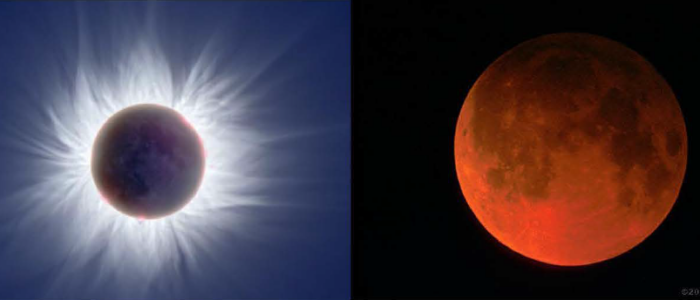Periodicity of Solar and Lunar Eclipses: The When, Where, and Why of Eclipses
MOUND MUSEUM LECTURE SERIES SPOTLIGHTS
Summary
Eclipses have been described as mysterious, ethereal, even spiritual experiences, especially Solar Eclipses. Lunar Eclipses more plodding, pedestrian, perhaps even boring in their occurrence. Solar Eclipses last mere minutes while Lunar Eclipses take hours to complete. Lunar Eclipses seem to occur every couple of years or so, while Solar Eclipses seem to occur on multi-decade intervals. Both are caused by the same Moon, the same lunar orbit, the same Sun, same Earth, same positional mechanisms and motions, yet they are so different in their frequency and experience. Beyond the clear difference between Solar and Lunar Eclipses, there is a great deal of variation within each type. Solar and Lunar Eclipses occur with equal frequency and duration. Patterns of Solar and Lunar eclipse occurrence and type variation are also essentially identical.
The Greeks, the Babylonians, and even the Sumerians (2000 BCE) observed the Moon long enough and carefully enough to recognize patterns of eclipses, both solar and lunar. They could predict eclipses with extraordinary accuracy. The Greek astronomer Thales predicted an eclipse on May 28th, 584 BCE in (modern day) Turkey that stopped a war. Eclipses are frightening to the uninitiated and astronomers used to have political clout. Don’t forget the Mayans and the Incas who also had of their own patterns. Lunar or Solar, eclipses don’t seem to follow any pattern. Visibility locations seem to be random over the Earth and eclipses don’t occur very often … or do they? It’s time for us to take a closer look at these interval patterns and see if we can predict eclipses as accurately as the ancients.
Speaker
Dave Bosse has been an amateur astronomer and sky-watcher ever since watching Sputnik cross the Cincinnati skies in 1957. Dave has volunteered as a presenter and lecturer at the Cincinnati Observatory for over 23 years and taught the popular monthly A2Z Astronomy class at the Observatory for 11 years. He has taught Computer Science and Astronomy courses for the University of Cincinnati for 42 years retiring in 2019. He has served the Observatory as President of Friends Of The Observatory, Trustee of FOTO and member of the Cincinnati Observatory Center Board of Trustees. After wandering through the University of Cincinnati’s Engineering College Chemical and Nuclear Engineering program for a couple of years, he finally settled into an Information Processing program. In UC’s Information Technology and Planning Department, Dave worked with Dr. Paul Herget, modernizing the computer processes of the International Astronomical Union’s Minor Planet Center, which Dr. Herget had run since 1947, combining Dave’s love of Astronomy and his extensive knowledge of machine language computer processes, especially Orbital Mechanics.
For additional details on this presentation call 937-247-0402 (MCWDC) or 937-353-4457 (MSEMA). The presentation is free and open to the public and has ample free parking.
Mound Cold War Discovery Center
E-Mail: msem475@gmail.com
Phone: 937-247-0402
Web: www.daytonhistory.org


Comments are closed.